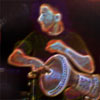Arabic Rhythm Patterns


Further study on this subject: Ancient Traditions–Future Possibilities:
Rhythmic Training Through the Traditions of Africa, Bali and India.
By Matthew Montfort. Ancient Future Music (1985).
ISBN 0-937879-00-2. Book/CD Set- 74.95. SALE! $53.95:
Add Book/CD to Cart. Buy Book/CD Now.
30 Minute Online Lesson.
Custom private lesson via Zoom or other service. $44:
Rhythm in Arabic music is organized into cycles of beats and pauses. These rhythmic modes are known as iqa'at in many Arabic countries, but there are other names for this concept. In Egyptian music they are called durub. In North-Western Africa they are called mazim. In Turkish music rhythmic modes are known as usul and in Iran they are called darb. Each cycle consists of a fixed number of metric pulses (which vary between 3 to 48 or more), including a hierarchy of strong beats, weak beats, and silent beats that define a groove. In performance some of the rests or silent beats may be filled in, but the underlying feel is maintained.
The sounding beats vary in timbre and are described with onomatopoeic syllables. The strong beat (an-naqra al-qawiya) is described using the syllable "dum" for the heavy low-pitched center sound of the drum. The weak beat (an-naqra al-laiyina) is represented by the word "tek" for the bright, high-pitched edge or side sound of the drum. While sometimes it is also translated as the soft beat rather than the weak beat, it is not necessarily less loud than the strong beat. In some ways, it shares a similar feeling to the off-beat in Western music.
One could use these two elements to demonstrate Western rhythms. For instance, a simple rock drum beat could be written as:
1 2 3 4
dum tek dum tek
A waltz could be written as:
1 2 3
dum tek tek
The all-pervasive electronic-techno-every-beat-strong groove that seems to have become the only rhythm many people are now able to dance to would be:
1 2 3 4
dum dum dum dum
Fortunately, Arabic rhythm contains more subtlety and variation than the current state of techno music! The medium beat (an-naqra al-mutawassita) is used to embellish the rhythm. While the strong and weak beats define the rhythm, the rhythmic pattern is enhanced through the addition of medium beats: variations that show the true skill of the player. In the terminology used here for strong, medium, and weak beats, the term "beat" does not necessarily imply that each beat has an equal metric pulse the way the term is used in Western music, especially with respect to the embellishing medium beats.
Arabic Grooves
The number of rhythmic modes has grown from eight in the 9th century to more than 100 today. Two 8 beat rhythms are presented here. More will be added as time permits.
Elzaffa
The recording of this rhythm is from the percussion tracks that Lebanese percussionist Antoine Lammam played on the song "El Zaffa" from the Planet Passion CD by Ancient Future. The MIDI file is an exact replication of those precussion tracks, and was even groove and velocity quantized to them to acheive a slightly more human sounding effect.
In Egypt, elzaffa, or wedding march, is a musical procession of drums. The main pattern is 8 beats long.
1 + 2 + 3 + 4 + | 1 + 2 + 3 + 4 + |
dum tek ka tek tek dum tek tek (tek ka)
dum (right hand clear low tone)
tek (right hand high crisp tone)
ka (left hand, sounds like tek)
After learning the traditional rhythm, listen to Ancient Future's world fusion composition in this rhythmic mode featuring the beautiful playing of Antoine Lammam, which shows that even the most human sounding computer music cannot compare to the rhythmic poetry of a great master.
El Zaffa 4:26 (Matthew Montfort. © 2001 Ancient Future Music). iTunes. >YTmusic. Full version/best audio quality appears on Planet Passion (Ancient-Future.Com AF-2010) CD/Gift Card, $17.98: Add CD to Cart. Buy CD Now.
Chiftitelli
Chiftitelli is the Turkish word for belly dancing. It is also an 8 beat rhythm popular with belly dancers. Notice that it is very similar to elzaffa. The difference is the use of the 3-3-2 accent pattern in the first four beats.
1 + 2 + 3 + 4 + | 1 + 2 + 3 + 4 + |
dum tek tek tek tek dum dum tek
1 2 3 1 2 3 1 2
Further Resources
Ancient Rhythms–Future Grooves
Ancient Rhythms–Future Grooves: Audio and MIDI Percussion Groove Tracks from the Traditions of Africa, Bali, and India. Want more audio and MIDI files? Get this complete collection of groove tracks from the book Ancient Traditions–Future Possibilities. For a limited time, get both the book and the enhanced audio CD set with MIDI files for only $53.95 (SALE! Normally $74.95): Add 1 to Cart. Buy 1 Now.
Once the student has mastered all of the rhythms in the book Ancient Traditions–Future Possibilities, Arabic rhythms will be much more easily assimilated, as Arabic rhythms share elements with Asian and African traditions.
Skype School => Zoom Room
Further instruction on this material is available through private Zoom lessons with the author, Matthew Montfort.

